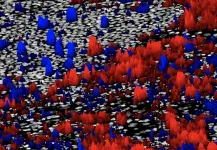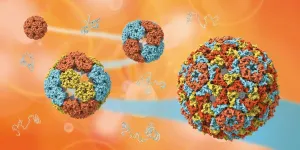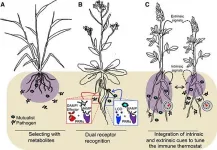(Press-News.org) WACO, Texas (June 9, 2021) - Most people listen to music throughout their day and often near bedtime to wind down. But can that actually cause your sleep to suffer? When sleep researcher Michael Scullin, Ph.D., associate professor of psychology and neuroscience at Baylor University, realized he was waking in the middle of the night with a song stuck in his head, he saw an opportunity to study how music -- and particularly stuck songs -- might affect sleep patterns.
Scullin's recent study, published in Psychological Science, investigated the relationship between music listening and sleep, focusing on a rarely-explored mechanism: involuntary musical imagery, or "earworms," when a song or tune replays over and over in a person's mind. These commonly happen while awake, but Scullin found that they also can happen while trying to sleep.
"Our brains continue to process music even when none is playing, including apparently while we are asleep," Scullin said. "Everyone knows that music listening feels good. Adolescents and young adults routinely listen to music near bedtime. But sometimes you can have too much of a good thing. The more you listen to music, the more likely you are to catch an earworm that won't go away at bedtime. When that happens, chances are your sleep is going to suffer."
People who experience earworms regularly at night -- one or more times per week -- are six times as likely to have poor sleep quality compared to people who rarely experience earworms. Surprisingly, the study found that some instrumental music is more likely to lead to earworms and disrupt sleep quality than lyrical music.
The study involved a survey and a laboratory experiment. The survey involved 209 participants who completed a series of surveys on sleep quality, music listening habits and earworm frequency, including how often they experienced an earworm while trying to fall asleep, waking up in the middle of the night and immediately upon waking in the morning.
In the experimental study, 50 participants were brought into Scullin's Sleep Neuroscience and Cognition Laboratory at Baylor, where the research team attempted to induce earworms to determine how it affected sleep quality. Polysomnography -- a comprehensive test and the gold standard measurement for sleep -- was used to record the participants' brain waves, heart rate, breathing and more while they slept.
"Before bedtime, we played three popular and catchy songs -- Taylor Swift's 'Shake It Off,' Carly Rae Jepsen's 'Call Me Maybe' and Journey's 'Don't Stop Believin'," Scullin said. "We randomly assigned participants to listen to the original versions of those songs or the de-lyricized instrumental versions of the songs. Participants responded whether and when they experienced an earworm. Then we analyzed whether that impacted their nighttime sleep physiology. People who caught an earworm had greater difficulty falling asleep, more nighttime awakenings, and spent more time in light stages of sleep."
Additionally, EEG readings -- records of electrical activity in the brain -- from the experimental study were quantitatively analyzed to examine physiological markers of sleep-dependent memory consolidation. Memory consolidation is the process by which temporary memories are spontaneously reactived during sleep and transformed into a more long-term form.
"We thought that people would have earworms at bedtime when they were trying to fall asleep, but we certainly didn't know that people would report regularly waking up from sleep with an earworm. But we saw that in both the survey and experimental study," he said.
Participants who had a sleep earworm showed more slow oscillations during sleep, a marker of memory reactivation. The increase in slow oscillations was dominant over the region corresponding to the primary auditory cortex which is implicated in earworm processing when people are awake.
"Almost everyone thought music improves their sleep, but we found those who listened to more music slept worse," Scullin said. "What was really surprising was that instrumental music led to worse sleep quality -- instrumental music leads to about twice as many earworms."
The study found that individuals with greater music listening habits experienced persistent earworms and a decline in sleep quality. These results are contrary to the idea of music as a hypnotic that might help sleep. Health organizations commonly recommend listening to quiet music before bedtime -- recommendations that largely arise from self-reported studies. Instead, Scullin has objectively measured that the sleeping brain continues to process music for several hours, even after the music stops.
Knowing that earworms negatively affect sleep, Scullin recommends first trying to moderate music listening or taking occasional breaks if bothered by earworms. Timing of music also is important -- try to avoid it before bed.
"If you commonly pair listening to music while being in bed, then you'll have that association where being in that context might trigger an earworm even when you're not listening to music, such as when you're trying to fall asleep," he said.
Another way to get rid of an earworm is to engage in cognitive activity -- fully focusing on a task, problem or activity helps to distract your brain from earworms. Near bedtime, rather than engaging in a demanding activity or something that would disrupt your sleep, like watching TV or playing video games, Scullin suggests spending five to 10 minutes writing out a to-do list and putting thoughts to paper. A previous study by Scullin -- partially funded by a National Institutes of Health grant and the Sleep Research Society Foundation -- found that participants who took five minutes to write down upcoming tasks before bed helped "offload" those worrying thoughts about the future and led to faster sleep.
INFORMATION:
*Co-authors for the study were Chenlu Gao, Ph.D. '21, post-doc researcher at Harvard Medical School, and Paul Fillmore, Ph.D., assistant professor of communication sciences and disorders at Baylor.
ABOUT BAYLOR UNIVERSITY
Baylor University is a private Christian University and a nationally ranked research institution. The University provides a vibrant campus community for more than 19,000 students by blending interdisciplinary research with an international reputation for educational excellence and a faculty commitment to teaching and scholarship. Chartered in 1845 by the Republic of Texas through the efforts of Baptist pioneers, Baylor is the oldest continually operating University in Texas. Located in Waco, Baylor welcomes students from all 50 states and more than 90 countries to study a broad range of degrees among its 12 nationally recognized academic divisions.
June 10, 2021, CLEVELAND: A new Cleveland Clinic-led study has identified mechanisms by which COVID-19 can lead to Alzheimer's disease-like dementia. The findings, published in Alzheimer's Research & Therapy, indicate an overlap between COVID-19 and brain changes common in Alzheimer's, and may help inform risk management and therapeutic strategies for COVID-19-associated cognitive impairment.
Reports of neurological complications in COVID-19 patients and "long-hauler" patients whose symptoms persist after the infection clears are becoming more common, suggesting that SARS-CoV-2 (the virus that causes COVID-19) may have lasting effects on brain function. However, it is not yet well understood how the virus leads to neurological issues.
"While some studies suggest ...
The human heart contracts about 70 times per minute, while that of a rat contracts over 300 times; what accounts for this difference? In a new study publishing 10th June in the open-access journal PLOS Biology, led by Michael Geeves and Mark Wass of the University of Kent and Leslie Leinwand from the University of Colorado Boulder, reveal the molecular differences in the heart muscle protein beta myosin that underly the large difference in contraction velocity between the two species.
Myosin is a "molecular motor" - an intricate nanomachine that forms the dynamic core of a muscle's contractile machinery, burning ...
Pairing sky-mapping algorithms with advanced immunofluorescence imaging of cancer biopsies, researchers at The Mark Foundation Center for Advanced Genomics and Imaging at Johns Hopkins University and the Bloomberg~Kimmel Institute for Cancer Immunotherapy developed a robust platform to guide immunotherapy by predicting which cancers will respond to specific therapies targeting the immune system.
A new platform, called AstroPath, melds astronomic image analysis and mapping with pathology specimens to analyze microscopic images of tumors.
Immunofluorescent imaging, using antibodies with fluorescent tags, enables researchers to visualize multiple cellular proteins simultaneously and determine their pattern and strength of expression. Applying AstroPath, ...
The team say their findings have implications for the treatment of viruses in future.
Researchers from the Universities of York and Leeds, collaborating with the Hilvert Laboratory at the ETH Zürich, studied the structure, assembly and evolution of a 'container' composed of a bacterial enzyme.
The study - published in the journal Science - details the structural transformation of these virus-like particles into larger protein 'containers'.
It also reveals that packaging of the genetic cargo in these containers becomes more efficient during the later stages of evolution. They show that this is because the genome inside evolves hallmarks of a mechanism widely ...
The specific traits of a plant's roots determine the climatic conditions under which a particular plant prevails. A new study led by the University of Wyoming sheds light on this relationship -- and challenges the nature of ecological trade-offs.
Daniel Laughlin, an associate professor in the UW Department of Botany and director of the Global Vegetation Project, led the study, which included researchers from the German Centre for Integrative Biodiversity Research in Leipzig, Germany; Leipzig University; and Wageningen University & Research in Wageningen, Netherlands.
"We found that root traits can explain species distributions across the planet, which has never been attempted ...
It's often cancer's spread, not the original tumor, that poses the disease's most deadly risk.
"And yet metastasis is one of the most poorly understood aspects of cancer biology," says Kamen Simeonov, an M.D.-Ph.D. student at the University of Pennsylvania Perelman School of Medicine.
In a new study, a team led by Simeonov and School of Veterinary Medicine professor Christopher Lengner has made strides toward deepening that understanding by tracking the development of metastatic cells. Their work used a mouse model of pancreatic cancer and cutting-edge techniques to trace the lineage and gene expression patterns of individual cancer cells. They found a spectrum of aggression in the cells that arose, with cells ...
WOODS HOLE, Mass. -- Many animals have evolved camouflage tactics for self-defense, but some butterflies and moths have taken it even further: They've developed transparent wings, making them almost invisible to predators.
A team led by Marine Biological Laboratory (MBL) scientists studied the development of one such species, the glasswing butterfly, Greta oto, to see through the secrets of this natural stealth technology. Their work was published in the Journal of Experimental Biology.
Although transparent structures in animals are well established, they appear far more often in ...
Because of a phenomenon called gravitational locking, the Moon always faces the Earth from the same side. This proved useful in the early lunar landing missions in the 20th century, as there was always a direct line of sight for uninterrupted radiocommunications between Earth ground stations and equipment on the Moon. However, gravitational locking makes exploring the hidden face of the moon--the far side--much more challenging, because signals cannot be sent directly across the Moon towards Earth.
Still, in January 2019, China's lunar probe Chang'e-4 marked the first time a spacecraft landed on the far side of the Moon. Both the lander and the lunar rover it carried have been gathering and sending back images and ...
Philadelphia, June 10, 2021 - A new study from researchers at Children's Hospital of Philadelphia (CHOP) and the University of Pennsylvania's Annenberg Public Policy Center found that 18- to 24-year-olds who use cell phones while driving are more likely to engage in other risky driving behaviors associated with "acting-without-thinking," a form of impulsivity. These findings suggest the importance of developing new strategies to prevent risky driving in young adults, especially those with impulsive personalities. The study was recently published in the International Journal of Environmental Research Public Health.
Cell phone use while driving has been linked to increased crash and near-crash risk. Despite bans on handheld cell phone use ...
Plants are constantly exposed to microbes: pathogens that cause disease, commensals that cause no harm or benefit, and mutualists that promote plant growth or help fend off pathogens. For example, most land plants can form positive relationships with arbuscular mycorrhizal fungi to improve nutrient uptake. How plants fight off pathogens without also killing beneficial microbes or wasting energy on commensal microbes is a largely unanswered question.
In fact, when scientists within the field of Molecular Plant-Microbe Interactions were asked to come up with their Top 10 Unanswered Questions, the #1 question was "How do plants engage with beneficial microorganisms while at the same time restricting ...







